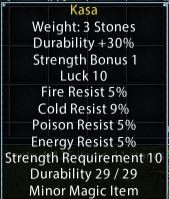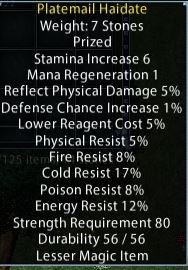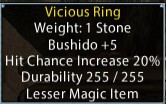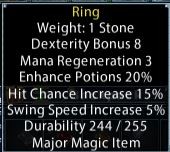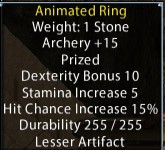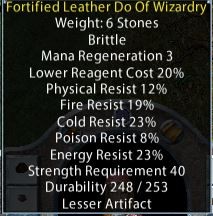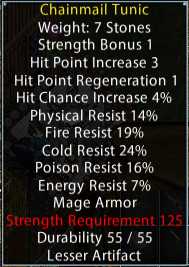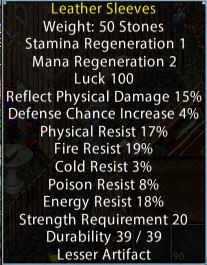The Random Loot Generator came into use as part of the Shame Dungeon revamp, publish 73, 2011. In publish 86, September 2014 all random loot, globally, became generated in this way.
Named Quest Rewards and Artifacts from the various Artifact Collections, having fixed, not random, properties are not affected.
All magical items (weapons, armor, and jewelry) spawn with properties generated by the Random Loot Generator. These include items found,
- On Monsters
- In SoS Chests
- In Treasure Chests
- In Dungeon Chests
- In Khaldun Puzzle Chests
- In Paragon Chests
- From Dredging Hooks
- From Quest rewards
- Lost Items (Honesty Virtue)
- Loot obtained from monsters, SoS Chests, Treasure Chests, Dredging Hooks, and as Quest Rewards will be influenced by the luck of the individual getting the loot.
- Loot obtained from Dungeon Chests and Khaldun Puzzle Chests will have loot influenced with a random luck value between 0 and 240.
- Loot generated in Felucca has a 1000 point luck bonus applied to it, as well as bonuses to budgets used in item property generation.
- Additional monster loot items will be spawned based on party size and luck.
- Item insurance scales up based on item intensity.
- Magical jewelry (rings and bracelets) has a default max durability of 255.
All items will have one of the following 8 designations near the bottom of the tool tip (in ascending order of intensity, examples below):
- Minor Magic Item
- Lesser Magic Item
- Greater Magic Item
- Major Magic Item
- Lesser Artifact
- Greater Artifact
- Major Artifact
- Legendary Artifact
Lesser Artifacts are approximately equivalent to an item imbued to maximum weight.
Some items will have ‘grouped’ properties fitting a theme, these are named.
Items can be:
- unnamed, random properties
- prefix only (properties from one theme, some random)
- suffix only (properties from one theme, some random
- Prefix and suffix (properties from two different themes)
Creature Strength
The strength of an item generated depends partially on the strength and toughness of the creature killed.
There is a very small chance that a loot drop will be a very powerful item. This can happen with weak creatures, but is extremely rare. This is more likely to happen with stronger creatures. Luck significantly increases the chance of this happening.
Item Strength
Weak items
- Typically: unnamed with 5 random properties at low values
- Occasionally: named with fewer than 5 properties, allowing for imbuing
- Usually: have no disadvantages
Strong items
- Typically: will have 5 item properties
- Frequently: will be named
- Usually: will have a disadvantage
Extremely powerful items
- Sometimes: will have more than 5 properties.
- Usually: will have a disadvantage
Item Properties
- Luck only appears in increments of 10
- Skill bonuses only appear in increments of 5
- Property values can exceed existing caps
- Properties can appear on item types that historically did not have that property, and cannot be imbued with it. (eg mana regen or swing speed increase on jewellery)
- Some properties may be temporary, ie spell effects with a set number of ‘charges’
- Resistance on armor will count as one of the item’s properties when it exceeds the base property of the armor type +15 ie the ‘imbue cap’.
Disadvantages
These appear on items randomly, items that are free of disadvantages, ie ‘clean’ can be generated. Weak items are frequently ‘clean’, powerful items are very rarely ‘clean’. Luck has no influence on the frequency of item disadvantage generation.
The following negative item properties can now be found on magic items:
- Brittle – Cannot have powder of fortification applied to the item, will have a default max durability of 255
- Prized – Item insurance cost is increased, cannot be blessed
- Massive – Increased strength requirement (example below)
- Unwieldy – Increased item weight (example below)
- Cursed – Cannot be insured or blessed
- Antique – Increased durability loss, can be powdered 3 times (excluding jewelry, which cannot be powdered). Each powder will reduce max durability to 250, 200, and 150 respectively. Can be repaired.
Items will have at maximum 1 negative property applied to them.
The item on the left is massive, having a strength requirement of 125. That on the right is unwieldy, having a weight of 50 stones.
How it Works
Creatures are assigned a difficulty rating. When the creature is killed, its Difficulty Rating and the killers’ Luck factor into loot generation. More difficult creatures generate more items. Additional monster loot items will be spawned based on party size and luck.
Generation, Step 1. The Item Budget
- Each item receives a base item property budget and a bonus item property budget
- The bonus property budget may be added multiple times. The higher the killer’s Luck, the higher the chance of multiple Bonus Budget
Generation, Step 2. The Final Budget
- The higher the Budget, the more Disadvantage Rolls are made for the item
- Each Disadvantage Roll has a chance of adding/changing a Disadvantage
- The Disadvantage adds a fixed bonus to the item’s Budget
Generation, Step 3.
- The higher the final budget, the greater the chance of generating named items
- The higher the final budget, the more properties will be added
Finally, the budget is spent to add item properties to the item.

